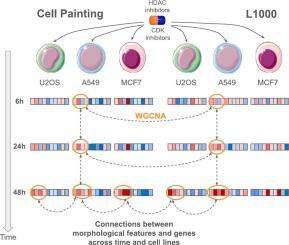Cell morphology and gene expression: tracking changes and complementarity across time and cell lines
IF 3.4
3区 医学
Q2 PHARMACOLOGY & PHARMACY
引用次数: 0
Abstract
Effective drug discovery relies on combining target knowledge with functional assays and multi-omics data to understand chemicals' molecular actions. However, the relationship between changes in cell morphology and gene expression deregulation over the duration of exposure and across cell lines following chemical exposition remains unclear. To explore this, we analyzed Cell Painting and L1000 data for 106 compounds across three cell lines from osteoblast, lung, and breast tumors (U2OS, A549, and MCF7) at three time points (6 h, 24 h, 48 h) using a 10 μM concentration. Following chemical exposure, we observed significant and specific differences in the spatial organization of cellular structures and components over time and across cell lines in the Cell Painting data, whereas transcriptomic responses showed less pronounced variability. Using Weighted Gene Co-expression Network Analysis (WGCNA) and enrichment analysis, we identified connections between cell morphology and gene deregulation for chemicals with similar biological effects (e.g., HDAC and CDK inhibitors). These findings suggest that while Cell Painting shows distinct patterns, both technologies offer complementary insights into compound-induced cellular changes, enhancing drug discovery and chemical risk assessment.

细胞形态和基因表达:跨越时间和细胞系的跟踪变化和互补性
有效的药物发现依赖于将靶标知识与功能分析和多组学数据相结合,以了解化学物质的分子作用。然而,细胞形态的变化和基因表达的放松在暴露的持续时间和化学暴露后的细胞系之间的关系仍然不清楚。为了探讨这一点,我们分析了来自成骨细胞、肺和乳腺肿瘤的三种细胞系(U2OS、A549和MCF7)在三个时间点(6小时、24小时、48小时)使用10 μM浓度的106种化合物的Cell Painting和L1000数据。在化学物质暴露后,我们观察到细胞结构和成分的空间组织随着时间的推移和细胞系的不同而存在显著和特定的差异,而转录组反应则显示出不太明显的可变性。利用加权基因共表达网络分析(WGCNA)和富集分析,我们确定了具有类似生物效应的化学物质(如HDAC和CDK抑制剂)的细胞形态和基因失调之间的联系。这些发现表明,虽然细胞绘画显示出不同的模式,但这两种技术为化合物诱导的细胞变化提供了互补的见解,增强了药物发现和化学风险评估。
本文章由计算机程序翻译,如有差异,请以英文原文为准。
求助全文
约1分钟内获得全文
求助全文
来源期刊
CiteScore
6.80
自引率
2.60%
发文量
309
审稿时长
32 days
期刊介绍:
Toxicology and Applied Pharmacology publishes original scientific research of relevance to animals or humans pertaining to the action of chemicals, drugs, or chemically-defined natural products.
Regular articles address mechanistic approaches to physiological, pharmacologic, biochemical, cellular, or molecular understanding of toxicologic/pathologic lesions and to methods used to describe these responses. Safety Science articles address outstanding state-of-the-art preclinical and human translational characterization of drug and chemical safety employing cutting-edge science. Highly significant Regulatory Safety Science articles will also be considered in this category. Papers concerned with alternatives to the use of experimental animals are encouraged.
Short articles report on high impact studies of broad interest to readers of TAAP that would benefit from rapid publication. These articles should contain no more than a combined total of four figures and tables. Authors should include in their cover letter the justification for consideration of their manuscript as a short article.

 求助内容:
求助内容: 应助结果提醒方式:
应助结果提醒方式:


